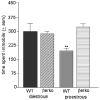Adult female wildtype, but not oestrogen receptor beta knockout, mice have decreased depression-like behaviour during pro-oestrus and following administration of oestradiol or diarylpropionitrile
- PMID: 18562442
- PMCID: PMC3623951
- DOI: 10.1177/0269881108089598
Adult female wildtype, but not oestrogen receptor beta knockout, mice have decreased depression-like behaviour during pro-oestrus and following administration of oestradiol or diarylpropionitrile
Abstract
Studies in people and animal models suggest that depression is influenced by natural fluctuations in the levels of 17beta-oestradiol (E(2)), as well as administration of E(2)-based therapies, such as selective oestrogen receptor modulators (SERMs). Elucidating the effects and mechanisms of E(2) is important to improve future E(2)-based therapeutics. An important question is whether effects of E(2) or SERMs for mood regulation act at the alpha or beta isoform of the oestrogen receptor (ER) because some of the unwanted trophic effects of E(2)-based therapies may involve actions at ERalpha, rather than ERbeta. In the present study, whether there are sex differences in depression-like behaviour of adult mice (experiment 1), and the effects of natural fluctuations in E(2) (experiment 2), or administration of E(2) or a SERM that has higher affinity for ERbeta than for ERalpha (diarylpropionitrile; DPN) to ovariectomised (experiment 3) wildtype and ERbeta knockout (betaERKO) mice were investigated. Results of this study supported our hypotheses that: there would be sex differences favouring males for depression-like behaviour and endogenous increases in, or exogenous administration of, E(2) or administration of an ERbeta SERM would decrease depression-like behaviour in wildtype, but not betaERKO, mice. In experiment 1, adult male mice spent less time immobile in the forced swim test (i.e., showed less depression-like behaviour) compared with female mice. In experiment 2, pro-oestrous (higher circulating E(2) levels), compared with dioestrous (lower circulating E(2) levels), mice had reduced immobility in the forced swim test; this effect was not observed in betaERKO mice. In experiment 3, administration of E(2) or DPN to ovariectomised wildtype, but not betaERKO, mice decreased immobility compared with vehicle administration, these data suggest that ERbeta may be required for some of the anti-depressant-like effects of E(2).
Figures



Similar articles
-
Estradiol or diarylpropionitrile administration to wild type, but not estrogen receptor beta knockout, mice enhances performance in the object recognition and object placement tasks.Neurobiol Learn Mem. 2008 May;89(4):513-21. doi: 10.1016/j.nlm.2008.01.008. Epub 2008 Mar 3. Neurobiol Learn Mem. 2008. PMID: 18313947 Free PMC article.
-
Administration of estrogen receptor beta-specific selective estrogen receptor modulators to the hippocampus decrease anxiety and depressive behavior of ovariectomized rats.Pharmacol Biochem Behav. 2007 Feb;86(2):407-14. doi: 10.1016/j.pbb.2006.07.003. Epub 2006 Aug 17. Pharmacol Biochem Behav. 2007. PMID: 16916539
-
Oestrogen receptor ERα and ERβ agonists ameliorate oxidative brain injury and improve memory dysfunction in rats with an epileptic seizure.Exp Physiol. 2019 Dec;104(12):1911-1928. doi: 10.1113/EP087986. Epub 2019 Nov 15. Exp Physiol. 2019. PMID: 31608530
-
Estrogen receptor beta: an overview and update.Nucl Recept Signal. 2008 Feb 1;6:e003. doi: 10.1621/nrs.06003. Nucl Recept Signal. 2008. PMID: 18301783 Free PMC article. Review.
-
Oestrogen receptor beta is involved in the actions of oestrogens in the brain for affective behaviour, but not trophic effects in peripheral tissues.J Neuroendocrinol. 2010 Feb;22(2):141-51. doi: 10.1111/j.1365-2826.2009.01945.x. Epub 2009 Dec 15. J Neuroendocrinol. 2010. PMID: 20025628 Free PMC article. Review.
Cited by
-
Acute stress reveals different impacts in male and female Zdhhc7-deficient mice.Brain Struct Funct. 2021 Jun;226(5):1613-1626. doi: 10.1007/s00429-021-02275-y. Epub 2021 Apr 20. Brain Struct Funct. 2021. PMID: 33880616 Free PMC article.
-
Estrogen receptor β deficiency impairs BDNF-5-HT2A signaling in the hippocampus of female brain: A possible mechanism for menopausal depression.Psychoneuroendocrinology. 2017 Aug;82:107-116. doi: 10.1016/j.psyneuen.2017.05.016. Epub 2017 May 18. Psychoneuroendocrinology. 2017. PMID: 28544903 Free PMC article.
-
Chronic creatine supplementation alters depression-like behavior in rodents in a sex-dependent manner.Neuropsychopharmacology. 2010 Jan;35(2):534-46. doi: 10.1038/npp.2009.160. Neuropsychopharmacology. 2010. PMID: 19829292 Free PMC article.
-
The interaction of BDNF with estrogen in the development of hypertension and obesity, particularly during menopause.Front Endocrinol (Lausanne). 2024 Nov 25;15:1384159. doi: 10.3389/fendo.2024.1384159. eCollection 2024. Front Endocrinol (Lausanne). 2024. PMID: 39655343 Free PMC article. Review.
-
EFFICACY OF ESTRADIOL IN PERIMENOPAUSAL DEPRESSION: SO MUCH PROMISE AND SO FEW ANSWERS.Depress Anxiety. 2015 Aug;32(8):539-49. doi: 10.1002/da.22391. Epub 2015 Jun 30. Depress Anxiety. 2015. PMID: 26130315 Free PMC article.
References
-
- Akanmu MA, Adeoson SO, Ilesanmi OR. Neuropharmacological effects of oleamide in male and female mice. Behav Brain Res. 2007;182:88–94. - PubMed
-
- Alonso SJ, Damas C, Navarro E. Behavioral despair in mice after prenatal stress. J Physiol Biochem. 2000;56:77–82. - PubMed
-
- Barros HM, Ferigolo M. Ethopharmacology of imipramine in the forced-swimming test: gender differences. Neurosci Biobehav Rev. 1998;23:279–286. - PubMed
-
- Bebbington P, Hurry J, Tennant C, Sturt E, Wing JK. The epidemiology of mental disorders in Camberwell. Psychol Med. 1981;11:561–579. - PubMed
-
- Becker JB, Snyder PJ, Miller MM, Westgate SA, Jenuwine MJ. The influence of estrous cycle and intrastriatal estradiol on sensorimotor performance in the female rat. Pharmacol Biochem Behav. 1987;27:53–59. - PubMed
Publication types
MeSH terms
Substances
Grants and funding
LinkOut - more resources
Full Text Sources
Medical

